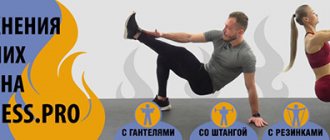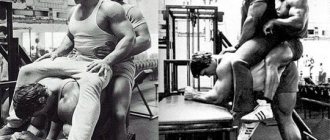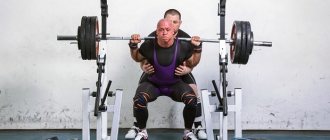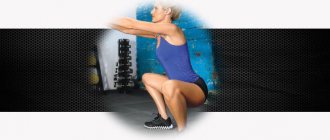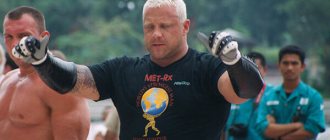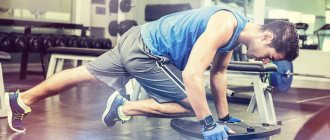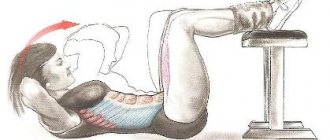The headstand is called the “king of all asanas” in ancient yoga texts. Let's figure out why this asana deserves its place of honor as the most famous and popular in yoga, although at the same time it is quite difficult to master for many practitioners. What effects does the practice of headstand have, how it can also harm our body, how to master a headstand and whether it’s worth doing it at all - we’ll look at it in our article.
Contraindications
Training in an upside down position cannot be practiced in the following cases:
- damage to joints in the elbow, shoulder and wrist areas;
- diseases of the spine;
- increased intracranial pressure;
- disturbances in the functioning of the cardiovascular system;
- presence of inflammation;
- pregnancy, especially the 2nd and 3rd trimester;
- period of menstruation.
If you are unsure whether you can exercise, discuss contraindications with your doctor.
Proper reach into handstand
Headstand: benefits
Headstand in Sanskrit is called Shirshasana (शीर्ष śīrṣa - 'head', आसन āsana - 'body position').
It refers to inverted asanas, when the body is completely inverted in a vertical position. The health benefits of headstand are undeniable, but only if you do it as correctly and safely as possible. Headstand
is one of the inversion poses that are known for their beneficial effects on the body. Let's consider what effects we can get from performing Shirshasana.
- Like all inverted poses, headstand
reverses all physiological and energetic processes, which is why it is believed to slow down the aging process. - There is a flow of blood to the head, which improves cerebral circulation and increases the supply of nutrients to the brain. Sirsasana helps strengthen blood vessels in the brain and can prevent headaches and migraines. It is also believed that headstand
can help slow down the process of hair loss and the appearance of gray hair on the head. - It has a beneficial effect on the cardiovascular system, reducing heart rate and blood pressure, increasing the flow of venous blood to the heart and cardiac output, as well as the lymphatic system, which, in turn, helps remove toxins from the body.
- It is also believed that blood flow to the head has a beneficial effect on the blood vessels of the eyes.
- Increases muscle endurance.
- Improves digestion.
- The vessels of the legs rest, which allows you to get rid of congestion in the lower part of the body. Swelling in the legs decreases. Headstand
is useful for varicose veins. - Improves blood circulation and circulation throughout the body. It has a beneficial effect on the functioning of the nervous, circulatory, respiratory, reproductive and endocrine systems.
- Stimulates the pineal gland and pituitary gland, responsible for growth and development, helps in the fight against diabetes.
- Headstand
increases parasympathetic tone, calms, helps relieve stress and nervous tension, anxiety, actively affecting the adrenal glands.
Safety precautions
Before learning how to do a handstand, prepare a training area. There should be no foreign objects near the wall and at a distance of 1.5-2 m so that you are not injured during a fall.
It is advisable not to lay anything on the floor - the palms touching a hard surface make the pose more stable. You can place a gymnastics mat or mats at a short distance from you - if you fall, this will soften the blow.
It’s great if there is a person nearby who will provide support if necessary. In addition, from the outside you can see the execution errors that he will point out to you.
Do not start learning with complex techniques, this is traumatic and ineffective.
If you feel dizzy during training, your eyes darken, stars appear and ringing in your ears, carefully lower yourself to the floor and lie down until your condition returns to normal. At first, this is considered normal, since the body is not accustomed to this position. After a few sessions you will no longer feel this.
Following the above rules will help you get only the benefits and not the harm from handstands.
Preparation: Build Strength and Endurance
We should also talk about the psychological mood. If you have heard information that it is impossible to learn at an adult age, without physical training or for any other reasons, do not believe it.
There are 4 main factors to achieve results:
- patience;
- force;
- endurance;
- sense of balance.
They need to be trained and developed daily.
Special attention should be paid to the feeling of fear of falling, which haunts many who decide to learn how to stand. It is especially familiar to people who have not previously engaged in physical activity.
A phobia can be easily overcome by trying to deliberately lose your balance a few times. This will help you understand how to fall correctly so as not to hurt yourself.
What does a headstand do?
We have looked at the benefits of a headstand in terms of its physiological effects, now let’s talk about what a headstand does from an energetic point of view.
Headstand
raises energy to higher centers and transfers consciousness to a higher level. Thus preparing for meditative practices, improving concentration, bringing attention inward, clarifying the mind and calming mental noise. However, we should not forget that the practice of asanas alone cannot achieve higher states of consciousness. You can stand on your head for a long time every day, but no enlightenment or insight will ever come to you, because yoga is a multifaceted system of self-development, which includes many tools for the development of consciousness. Remember that asanas are only a small part of this system.
Assistive exercises
Before you start training, learn how to warm up your muscles. This will be facilitated by a standard warm-up:
- inhale-exhale;
- head turns;
- body bends;
- lunges to the side.
It is recommended to master several exercises that help keep your muscles toned. This way you will learn everything faster.
Training the plank Push-up exercise Performing pull-ups on the horizontal bar
Push ups. Handstands place the main load on the shoulder and elbow joints. Therefore, it is important to train them for endurance. Holding in the lower position for half a minute will help enhance the effect of push-ups.
Pull-ups. Another effective way to strengthen your arm muscles. If you master the technique of performing this exercise, you will quickly learn how to do a handstand.
Plank. The pose affects all muscle groups and trains endurance. You need to start with 30-40 seconds, gradually increasing the duration.
Making a bridge
Crow Pose
Bridge. This pose develops flexibility and a sense of balance. You can get into it from a lying, sitting or standing position. Start with an easier option, and as you become more proficient, move on to the more difficult one.
Crow. This exercise trains the shoulder muscle groups and teaches how to properly distribute weight to maintain balance.
How to learn to stand on your hands: stages
You shouldn’t immediately throw yourself into the pool and try to stand up without support. Consistency in following the steps described below will help you achieve your goal.
Stand at support
First you need to learn how to do a handstand against a wall. This will allow you to feel how to correctly position your body parts to optimally distribute the load.
Stand facing the wall at a distance of 50 cm and gradually, leaning your toes against the wall, lift your body up so that your shoulders, pelvis and heels are on the same line perpendicular to the ground. Pull your stomach in and press your palms into the floor as hard as possible.
Handstand on a support
This is difficult to do, and you won’t learn it the first time. But we must not despair. A few tries and you will see the world upside down.
When you manage to take the desired position, fix your body for a few seconds. The interval should be gradually increased - the optimal time is 1 minute.
If this is still difficult for you, try adding the following steps:
- headstand;
- forearm stand;
- handstand.
In this way, you will learn to first stand with your hands covering most of the surface, narrowing it over time.
Walking
When you feel confident in the support, move on to the next stage.
It's called walking from side to side against a wall on your hands. To perform this, you should begin to move your palms at a distance of 10-15 cm to the left, trying to maintain a straight line of the body.
If you lose your balance, increase the distance between your feet. Don't forget to press your palms into the floor.
After taking a few steps to the side, return to the starting position in the same way. By walking along the support, you train endurance and learn to balance on your hands.
Shoulder touching
Once you have mastered the first two skills, move on to the next one. To perform it, stand upside down against a wall and tilt your body slightly to the side, making sure that your legs remain perpendicular to the floor.
Lift your palm from the floor and reach towards your shoulder, trying to touch it. It may not work out the first time, so there is no need to rush at this stage.
When you feel free to touch your shoulders in a handstand, hold the pose for a few seconds, gradually increasing the time to 1 minute.
Shoulder Touch in Handstand
Touching your shoulders will teach you to feel your balance, making it easier for you to stand without support.
Don't give up on wall-based exercises even if you've already mastered free-space handstands. This basic lesson will help keep your body in good shape and be ready for more complex workouts.
Headstand: execution technique
Later in the article we will give basic recommendations on how to do a headstand.
, however, it is important to understand that it is safer to master this asana under the guidance of a yoga teacher, rather than on your own.
The most important thing in a headstand is the ability to keep your spine straight, and the weight on your head should not exceed 10% of your total body weight. While performing Shirsasana, all the muscles of your body should be used. Please note that the headstand should be performed slowly and carefully.
- Get on your knees. Interlace your fingers, clasp your palms together, and place your forearms on the floor, with your elbows about the width of your forearm.
- Place the top of your head on your joined palms. The head should rest on the floor at a distance of four fingertips from the hairline.
- As you inhale, lift your knees off the floor. Get into an inverted position with your back straight, walking on the toes of your feet closer to your elbows (heels raised).
- Slowly lift your legs off the floor and draw your knees closer to your chest.
- Gently straighten your legs and keep them vertical.
- Distribute the weight evenly on your forearms and hold the position for the required time (from 10 seconds to 5-10 minutes depending on your level of training).
If mastering Shirshasana is still difficult, you can try doing a preparatory exercise for a headstand, using a chair as a support for your legs.
- Get into Dolphin Pose and clasp your head in your hands.
- Place your feet on a chair and try to lift one leg up first, then the other.
There are various variations of the technique of performing Shirsasana. For those starting to master this asana, it is most suitable to perform it near a wall (to protect yourself from falling), the technique of which we will consider in more detail later in the article.
Without support
Once you have mastered the wall exercises to develop balance, all that remains is to learn the basic technique. To do this, leaning upside down on the wall, take a small step forward with your hands. Make sure your shoulders are in line with your pelvis.
Lift one leg off the wall while maintaining balance. When you achieve stability, remove the other leg. Balance will help maintain proper load distribution. Most of the work should be done by the arm muscles.
How to do a handstand
Once you are comfortable doing a vertical wallstand, try free standing.
To learn how to take a pose, you need to first throw one leg up, and then the other, using swings:
- Get into a standing position.
- Extend one leg forward.
- Quickly step onto it, simultaneously tilting your body forward and lifting your other leg.
- Make sure it is parallel to your body.
- Forcefully swing the leg that is on the floor so that it stands next to the other.
- Don't overdo it to avoid a back flip.
- Look head forward, not down.
Now you can lower one leg, then the other and stand on the floor.
In order to understand how to properly stand on your hands, you need to ensure that your body is level, from head to heels. It should resemble a stretched string.
Correct positions
A straight stance is more difficult, a curved one is easier. To maintain balance at first, you can tuck or spread your legs.
Athletes recommend immediately training with straight legs. In the future, this will help you quickly master exercises such as walking or standing on one palm.
The correct position of the handstand determines whether it will benefit or, conversely, harm the body.
Pose "Candle"
If keeping your body in an extended position is difficult, try starting with an easier option.
The “candle” allows you to bend your knees and place them above head level. In this case, the center of gravity shifts, making it easier to learn to maintain balance.
It is safer to land on the floor from this pose. The exercise trains a sense of control over the body.
Pose "Candle"
Exit from the pose
In order not to harm yourself, you need to get back on your feet correctly after performing the exercise. There are several ways to do this.
Exit back - lower one leg to the floor in front of you, then the other.
Exiting the stance to the side is effective if you feel yourself starting to fall onto your back. Turn your body in the direction it led and try to lower one leg first, then the other.
Coming forward involves performing a somersault. Bow your head and press your chin to your neck. Lean back and lower your shoulders to the floor. Round your back and roll it across the floor. Ideally, you should get back to your feet after the somersault.
This trick is quite dangerous, so learn to do it on a gym mat.
Complication
Once you are confident in practicing free handstands, try to vary your workouts. Start with what you like best, gradually mastering other skills.
Walking
At first, it is better to train near a support or call an assistant. To learn to walk, do a handstand against a wall.
Then, leaning on the surface with your toes, raise your legs above your head and fix the pose. When you feel that you have control of your body, lift one leg off the wall, then the other.
Find your balance and move one palm forward slightly. Make sure that the body is one straight line.
Take a few steps and carefully stand on your feet. You should start the exercise with no more than 2-3 steps, gradually increasing their number.
Bars
Another option for how to do a handstand is an exercise on the uneven bars. Holding the machine with your palms will make it easier for you to maintain stability than if you lean on the floor.
Pirouette
This parallel bars exercise involves turning around its axis. To perform it you need a perfect sense of balance.
You need to move your palms one by one from one support to another to get a full turn. At the end of the exercise, stabilize the position and only then leave the pose.
Planche
The technique of performing the exercise is reminiscent of the “Plank” pose, with the difference that you should rely not on the floor, but on the bars.
The key to success in performing Planche is strong arm muscles. From the pose of standing upside down on supports, slowly lower your body so that the body remains motionless except for the shoulder joint. When finished you should be parallel to the ground.
The exercise will be completed successfully if you gradually shift the center of gravity forward.
When you learn how to do it, try lifting your body up from a horizontal pose.
The benefits of such a handstand will be doubled, since it involves all muscle groups in the body.
On 1 hand
A one-arm stand helps train the vestibular apparatus. It is quite difficult to perform - it requires a lot of endurance and patience.
Raising one arm up, the load on the other doubles, so it is important to do the exercise slowly and with maximum concentration.
Pushups
Another type of exercise that requires trained muscles of the shoulder joint. To maintain balance during this exercise, tilt your legs slightly forward, bend your knees and cross your calf muscles.
If handstand push-ups seem impossible for you, don’t give up on your desire. Practice shows that perseverance and regularity of practice certainly bears fruit.
Handstand push-ups
Headstand: contraindications
It is very important before performing any inverted asanas, and especially headstands, to familiarize yourself with the contraindications. You should not rush to master this asana if you have:
- problems with the neck and spine (protrusions, displacement of the vertebrae, pathologies of the cervical spine);
- there were traumatic brain injuries;
- arm and shoulder injuries;
- increased intracranial pressure, headache;
- high or low blood pressure (hypertension/hypotension);
- heart disease and heart failure;
- sinusitis;
- increased intraocular pressure, weak eye vessels;
- insomnia;
- pregnancy and menstruation (in women);
- postoperative period, also during recovery from injuries, refrain from performing a headstand.
If you find contraindications to performing a headstand, do not be discouraged, you can choose alternative inversions that will allow you to get the same positive effects, but with less risk to your health.
Headstand in yoga: how it can harm
If you decide to master the headstand, then first you need to familiarize yourself not only with the contraindications, but also with the important nuances of the technique of performing Shirshasana, so as not to harm your body.
If headstand
will be performed incorrectly, this can lead to injury, so follow the basic rules of injury prevention when performing Shirsasana. First, let's look at which muscles of the body are actively involved in performing a headstand and which asanas will help work them out in order to prepare the body for performing Shirsasana. Firstly, the abdominal muscles. If you have weak abdominals, then you will likely have difficulty mastering Shirshasana, since it is due to the activation of these muscles that the legs are lifted up. To strengthen the abdominal muscles, you can practice Paripurna Navasana and Ardha Navasana. Secondly, the hamstrings. Tight hamstrings can be a barrier to mastering the headstand. How easily you can perform forward bends, such as Uttanasana, with the ability to lower your hands to the floor, indicates whether you are ready to master Shirshasana. Thirdly, you must have fairly strong back muscles and a flexible spine. Shalabhasana or Bhujangasana will help strengthen the back muscles; dynamic vinyasas with alternating bends and bends will ensure flexibility of the spine. Fourthly, developed shoulder joints and strong arm muscles will allow you to confidently hold your body weight in this position. Perform all asanas where your arms are actively involved: arm balances, Chaturanga Dandasana, Vasishthasana.
Use quick tips on how to do a headstand
as safe as possible.
- When you lift your legs up, focus on placing your body weight on your arms and not on your head.
- If you feel like you might fall forward, tuck your chin towards your chest, this will allow you to avoid neck injuries.
- It is possible to injure your neck when performing a headstand because it is not designed to support the weight of your entire body. If performed incorrectly, it can lead to neck deformation or herniated intervertebral discs. Stretch your neck away from your ears: it should not be pinched, but straightened.
Errors
Beginners who don't know how to learn handstands will face a number of common mistakes.
Extend your arms over a long distance. This shifts the center of gravity and makes it difficult to maintain balance. Ideally, your palms should be shoulder-width apart.
Arms bent at the elbows. In this case, the main load falls on the elbow joint, which is likely to lead to injury. Your arms should be perfectly straight.
The body is tilted back and is behind the shoulders. You will never maintain your balance in this position. Try to keep your body straight. If you cannot control yourself, ask an assistant about it.
Bent spine. Another reason for your falls during your first workouts. Spread your shoulder blades and straighten your back.
By understanding how to avoid the most common mistakes, you will learn how to perform the exercise faster.
Physical training
You don’t have to be a “jock” to perform a handstand, but completely weakened muscles will not allow you to hold your body in an inverted position.
Those who practice parkour already have the necessary physical training. Those who have recently started have weaker muscles.
- To quickly learn how to stand on your hands, you will need to train them.
It is not necessary to build up prominent muscles on the shoulder girdle, but you need to be able to do a dozen pull-ups and 20-30 push-ups. This preparation will prevent you from falling during the stance (and injuring your neck or head).
- Formed torso muscles are required.
Let us repeat that they do not necessarily have to be convex and visible to the naked eye. The main thing is that they work and keep the body straight. A straight stance is the easiest option to perform the exercise.
- Back flexibility is as necessary for a parkourist as it is for a gymnast.
If you can easily perform a backbend and can lower yourself into a bridge from a standing position, you will learn to lower yourself into it from a vertical stance. This will give you confidence and reduce fears in training (“what if I land incorrectly, fall and get injured?”).
The last point is not mandatory for training. There are other ways to get out of the rack. Lowering onto the bridge requires some gymnastic skills that are not always available.
Advice from professionals
To learn handstand faster, follow these tips:
- lean on your fingers;
- learn to do push-ups;
- find balance and hold for a few seconds;
- practice stand-up entries;
- do not neglect help;
- systematize your classes;
- train with your face and back to the wall;
- get rid of fear.
Anyone can master the handstand, even without physical training. Its implementation has a beneficial effect on brain function, strengthens muscles and relieves problems with the spine. To achieve a positive result, patience and endurance are required.

